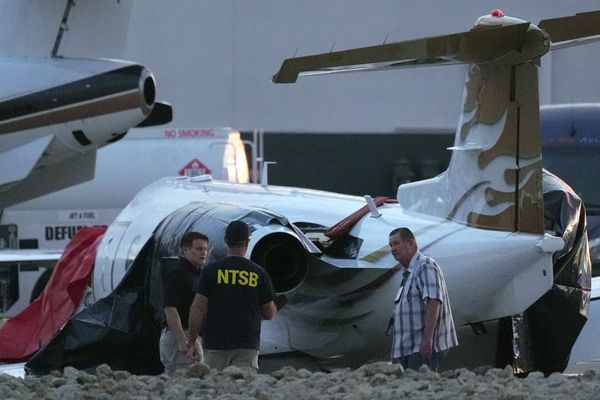KING SALMON, Alaska — Are you lucky enough to be traveling to Alaska this year? I am. If you are too, we’ll be two of an estimated 2.3 million visitors — cruise passengers, fishermen and independent travelers — heading north to “America’s Last Frontier.” After spending two years isolating at home, I’m more than ready for another trip to the 50th state. More than twice as large as Texas, Alaska has it all: mountains, glaciers, rivers, lakes, coastal bays, forests, tundra, even active volcanoes.
Lots of brown bears, too. Big hungry ones, for those of us lucky enough to see them up close.
After all, no arctic adventure should end without a whopper to tell and photos to prove it, posted online for your friends at home. You’ll probably see moose, eagles, caribou, whales, seals and maybe even wolves. But don’t count on spotting any brown bears — or grizzlies, as they’re called in the Lower 48.
Brown bears are loners. Bigger, heavier and more aggressive than their southern cousins, they avoid company, preferring distant hills, thick clumps of bushes and isolated creek beds.
You won’t see them wandering through your campsite or crossing the road between rows of gridlocked traffic, like their cousins in Yellowstone National Park. Not when they can avoid it. I learned that on a bus tour in Denali National Park, on my first trip to Alaska.
I was looking out the window at Denali, its snow-capped peak rising above the horizon, when the tour-bus guide suddenly hit the brakes, parked on the rim and grabbed his binoculars. “Over there! See the big rock, near the bushes,” he said, jumping up and pointing across the valley to a distant spot. In an instant, the rest of us passengers were on our feet, too, crowding against the windows and each other, peering, squinting and guessing until finally someone jabbed a finger at a distant brown smudge that looked more like a haystack.
It wasn’t until my second Alaska adventure, and subsequent close-ups with several 1,200-pound giants, that I discovered how easy it is to find and see bears, even at close range. The secret is obvious. Go where the bears go when they’re hungry and you’ll find them in all sizes. And where is that? To the rivers, brooks and creeks where millions of salmon return every year, swimming upstream to spawn.
Though Pacific salmon – Chinook (king), Sockeye (red), Coho (silver), Pink (humpback) and Chum (dog) – spend most of their adult lives in the ocean, they must spawn (lay and fertilize eggs) in the creek where their parents were spawned, no matter where that is. To accomplish this, they swim back to the coast, find the right river and swim upstream, doggedly oblivious to logs, rocks, the wrong tributaries, muddy pools, waterfalls, fishermen, bears, dams and even trout, which swim along behind looking for a tidbit.
The bears, meanwhile, hungry and impatient after a long winter, have been there for days or weeks, waiting, patrolling the stream banks and checking the water. At the first sign of the salmon, the bears hustle into the water, search the rocks, duck under in deep pools and snap at every nearby fish. When they catch one, they climb out onto a bank or gravel bar and holding the body down with a heavy paw, rip the body apart, devouring the richest parts and leaving the rest for the trout, minnows, insects and birds.
While the fish last, the bears pay no attention to strangers – fishermen, photographers and the curious. But don’t think they don’t see you. Find a safe place out of the action, and not too close. There are enough salmon to go around, but the bears don’t think so.
With so many fish and relatively few bears, it may seem that the fish who spawn and die are wasted. But with millions of salmon returning to Bristol Bay each year, there are more than enough. So many, in fact, that millions are caught and sold commercially. The rest, those that hobby fishermen don’t catch, will return to spawn not only the next generation, but to leave a gift behind — their bodies.
As countless bits of bone, meat and skin disintegrate they leave essential nutrients behind, returning them to the stream and he local biome. Everything benefits, from the trees, bushes, plants and the trout that follow. Also partaking of the bounty are beetles, snails, minnows, rabbits, mice, voles, birds, eagles and wolves. As long as climate change doesn’t ruin the oceans, or the salmon, we’ll always have bears.
In the meantime, how does one locate a stream with both bears and salmon? The easiest way is to spend a day fishing, or at least trying to fish. If your Alaska trip includes a free day in Anchorage, Dillingham, Kenai or Seward on the Kenai Peninsula (towns connected by roads), look online for a tour company leading one-day guided fishing trips to rivers with fish and bears. The price should include bus transportation, maybe lunch, snacks and fishing gear. Tell your guide you’ve a novice and they’ll set you up and show you what to do.
If you’re a cruise ship passenger on a ship docking in Alaska, ask the Shore Excursion desk if they arrange half-day flights to one of Alaska’s special bear-viewing sites, often located nearby, in a state or federal park. These fly-outs are expensive, but aerial views of Alaska are a once-in-a-lifetime experience. Flying low over creeks and forests you can see everything: wolves and moose in the trees below, herds of caribou on the hills, swans on their nests and white beluga whales cruising in ocean inlets. There’s no doubt about it, flight seeing in Alaska is always better than any theme park.
A better option, if you have the time or can plan in advance, is a three- to five-day stay at a fishing lodge on a salmon river with frequent bear sightings, meaning the back country, or at the end of a dirt road, or more likely, reachable only by float plane. Be aware: These lodges are on all rivers, and of many types, from plywood-sided cabins to five-star luxury retreats. All offer the basics, meaning overnight accommodations, meals, fishing gear, guides and boats. Since most fishermen want to take home their catch, they will quick-freeze it to take the airport.
Serious fishermen, who want to do nothing but fish all day every day, often choose a sports-style lodge with cabins at half the price. Guests who want the same fishing opportunities but in an authentic wilderness lodge with other guests, social cocktail hours, chef-prepared meals, a taste of Alaskan country living and floatplanes that fly you to all the nearby salmon rivers choose the full-service lodge at twice the price, or more. How can you tell? Search the internet, compare the lodges, and call for more information. Remember, you’re looking for bears.
———
The right stuff
WHERE: Many of the best salmon and trout-fishing lodges are in Southeast Alaska, on rivers flowing south into Bristol Bay. To see this area, find Dillingham and King Salmon on a map, then locate these salmon rivers – the Kvichak, Nushagak, Togiak, Naknek.
SEARCH ONLINE: For one-day guided fishing trips look in Anchorage, Kenai, Dillingham and Seward. Find lodges and best salmon streams at “ten top salmon streams,” at “salmon streams in Southeast Alaska,” at best fishing lodges Southeast Alaska,” and at “bear viewing in Southeast Alaska.” Related sites include: crystalcreeklodge.com; alaskatravel.com; anchorage.net; alaska.gov/visitorhome; kenaipeninsula.org; flyrusts.com; skytrekkingalaska.com; and withinthewild.com.
———
©The Syndicator 2022 Anne Z. Cooke.







